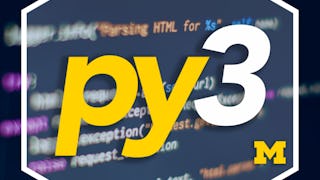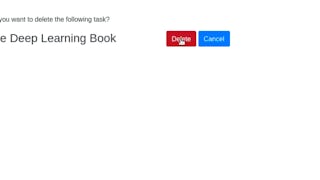This comprehensive beginner-level course equips learners with the skills to build, configure, and deploy full-featured web applications using the Python Pyramid framework. Through six progressively structured modules, learners will explore the core components of Pyramid, from setting up a virtual environment and configuring routing to designing scalable view logic, handling forms, and applying advanced rendering techniques.



Empfohlene Erfahrung
Kompetenzen, die Sie erwerben
- Kategorie: Performance Tuning
- Kategorie: Virtual Environment
- Kategorie: Application Deployment
- Kategorie: UI Components
- Kategorie: Configuration Management
- Kategorie: Model View Controller
- Kategorie: JSON
- Kategorie: Application Servers
- Kategorie: Server Side
Wichtige Details

Zu Ihrem LinkedIn-Profil hinzufügen
Juli 2025
18 Aufgaben
Erfahren Sie, wie Mitarbeiter führender Unternehmen gefragte Kompetenzen erwerben.

In diesem Kurs gibt es 6 Module
This module introduces learners to the Pyramid microframework and prepares the development environment using VirtualBox and Ubuntu. It guides the setup of essential dependencies, establishes the foundation for WSGI-based application development, and explores how Pyramid compares with other Python web frameworks. The module culminates in the creation of a basic Pyramid application, enabling learners to apply key architectural concepts and validate their setup.
Das ist alles enthalten
7 Videos3 Aufgaben
This module explores how Pyramid handles templates, asset specifications, and dynamic response rendering. Learners will examine view callables using both functions and classes, utilize multiple rendering engines, and understand how Pyramid automatically processes return values using response adapters. The module also focuses on performance enhancement through HTTP caching, introduces techniques for automating configuration using config.include(), and provides insight into advanced features like introspection and declarative configuration using decorators.
Das ist alles enthalten
8 Videos3 Aufgaben
This module guides learners through the practical steps of configuring, creating, and running a Pyramid web application. Beginning with a basic “Hello World” setup, the lessons explain the use of the WSGI server, routing mechanisms, and the essential configuration methods needed to map URLs to view callables. Learners also gain hands-on experience with setting up a Pyramid project using scaffolding tools, understanding the structure of a Pyramid package, and identifying the function of key directories such as templates/, static/, and __init__.py. By the end of this module, learners will be equipped to build and run a fully functional Pyramid application with proper configuration and project organization.
Das ist alles enthalten
7 Videos3 Aufgaben
This module provides an in-depth look at how Pyramid handles routing in web applications. Learners explore URL dispatching, dynamic and static route configuration, and the process of matching incoming requests to appropriate view callables. The module introduces route patterns, route matching order, and tools for generating URLs dynamically. It also covers the setup of static routes for serving assets like CSS and JavaScript, along with powerful debugging techniques using match dictionaries and predicates. Advanced topics such as predicate callables and route factories are also introduced to enable conditional routing and context-driven view resolution.
Das ist alles enthalten
9 Videos3 Aufgaben
This module explores the core concept of view callables in Pyramid, demonstrating how they receive requests, generate responses, and integrate with Pyramid’s routing and templating systems. Learners will understand how to define view callables using functions, classes, or callable objects and how to handle HTTP exceptions within views. The module also introduces practical techniques for handling form submissions, using built-in renderers such as JSON and Chameleon templates, and returning structured responses. By the end, learners will be able to construct interactive, form-driven web interfaces that respond dynamically to user input using Pyramid's flexible view and rendering system.
Das ist alles enthalten
6 Videos3 Aufgaben
This module focuses on advanced rendering techniques and template handling within Pyramid applications. Learners will explore how to manipulate response attributes such as content type and charset, use system values in templates, and directly control rendering behavior using built-in and custom renderers. The module introduces template macros for creating reusable UI components and explains how Pyramid integrates with Chameleon for efficient and maintainable server-side rendering. Attention is also given to the side effects of improper escaping and best practices for template structure and rendering performance.
Das ist alles enthalten
6 Videos3 Aufgaben
Erwerben Sie ein Karrierezertifikat.
Fügen Sie dieses Zeugnis Ihrem LinkedIn-Profil, Lebenslauf oder CV hinzu. Teilen Sie sie in Social Media und in Ihrer Leistungsbeurteilung.
Mehr von Software Development entdecken
 Status: Kostenloser Testzeitraum
Status: Kostenloser TestzeitraumUniversity of Michigan

Coursera Project Network
 Status: Kostenloser Testzeitraum
Status: Kostenloser TestzeitraumArizona State University

Coursera Project Network
Warum entscheiden sich Menschen für Coursera für ihre Karriere?





Neue Karrieremöglichkeiten mit Coursera Plus
Unbegrenzter Zugang zu 10,000+ Weltklasse-Kursen, praktischen Projekten und berufsqualifizierenden Zertifikatsprogrammen - alles in Ihrem Abonnement enthalten
Bringen Sie Ihre Karriere mit einem Online-Abschluss voran.
Erwerben Sie einen Abschluss von erstklassigen Universitäten – 100 % online
Schließen Sie sich mehr als 3.400 Unternehmen in aller Welt an, die sich für Coursera for Business entschieden haben.
Schulen Sie Ihre Mitarbeiter*innen, um sich in der digitalen Wirtschaft zu behaupten.
Häufig gestellte Fragen
Access to lectures and assignments depends on your type of enrollment. If you take a course in audit mode, you will be able to see most course materials for free. To access graded assignments and to earn a Certificate, you will need to purchase the Certificate experience, during or after your audit. If you don't see the audit option:
The course may not offer an audit option. You can try a Free Trial instead, or apply for Financial Aid.
The course may offer 'Full Course, No Certificate' instead. This option lets you see all course materials, submit required assessments, and get a final grade. This also means that you will not be able to purchase a Certificate experience.
When you purchase a Certificate you get access to all course materials, including graded assignments. Upon completing the course, your electronic Certificate will be added to your Accomplishments page - from there, you can print your Certificate or add it to your LinkedIn profile. If you only want to read and view the course content, you can audit the course for free.
You will be eligible for a full refund until two weeks after your payment date, or (for courses that have just launched) until two weeks after the first session of the course begins, whichever is later. You cannot receive a refund once you’ve earned a Course Certificate, even if you complete the course within the two-week refund period. See our full refund policy.
Weitere Fragen
Finanzielle Unterstützung verfügbar,

 enthalten
enthalten
